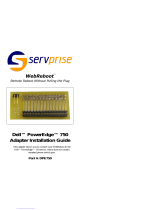Back to Contents Page
Hardware Installation
Dell™PowerEdge™ExpandableRAIDController4/SC,4/DC,and4e/DCUser'sGuide
Requirements
Quick Installation Procedure
Installation Steps
Requirements
This section describes the procedures for installing the RAID controller. You must have the following items to install the controller:
l A PERC 4/SC, 4/DC, or 4e/DC controller
l A host system with an available 32- or 64-bit, PCI extension slot for PERC 4/SC or 4/DC, and a PCI-Express slot for PERC 4e/DC
l The DellOpenManage™SystemsManagementCD or driver diskette
l The necessary internal and/or external SCSI cables
l Ultra, Ultra2, Ultra3, Ultra160, or Ultra320 SCSI hard drives
(SCSI is backward compatible, but it slows to the speed of the slowest device).
Quick Installation Procedure
Perform the following steps for quick installation of the controller if you are an experienced system user/installer. All others should follow the steps in the next
section, Installation Steps.
1. Turn off all power to the server and all hard drives, enclosures, and system components, then disconnect power cords from the system.
2. Open host system by following the instructions in the host system technical documentation.
3. Determine the SCSI ID and SCSI termination requirements.
4. Install the PERC 4/SC or 4/DC RAID controller in a PCI slot or the PERC 4e/DC in the PCI- Express slot in the server and attach the SCSI cables and
terminators.
See the section Cable Suggestions for cable information and suggestions.
l Make sure pin 1 on the cable matches pin 1 on the connector.
l Make sure that the SCSI cables conform to all SCSI specifications.
5. Perform a safety check.
l Make sure all cables are properly attached.
l Make sure the RAID controller is properly installed.
l Close the cabinet of the host system.
l Turn power on after completing the safety check.
6. Format the hard drives as needed.
7. Configure logical drives using the BIOS Configuration Utility or Dell Manager.
8. Initialize the logical drives.
9. Install the network operating system drivers as needed.




















